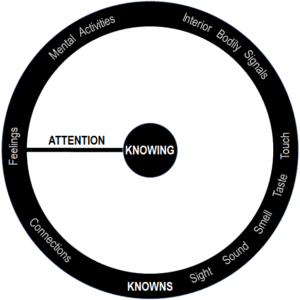While perusing Daniel Siegel’s book Aware: The Science and Practice of Presence, I came across a useful metaphor that has helped me get my head wrapped around mindfulness. He calls it the wheel of awareness.
 Think of the center of the wheel – the hub – as consciousness, or that state of being aware of one’s external environment and internal sensations and processes. Siegel refers to it as knowing. It’s that part of us that has the capacity for awareness.
Think of the center of the wheel – the hub – as consciousness, or that state of being aware of one’s external environment and internal sensations and processes. Siegel refers to it as knowing. It’s that part of us that has the capacity for awareness.
Consider the rim to include all of the things about which consciousness might be aware. Siegel labels it the knowns. The rim contains:
- Input from our 5 senses – i.e., sight, sound, taste, smell, touch
- Interior signals from the body – e.g., breath, heartbeat, digestion, body temperature
- Feeling states – e.g., happy, sad, angry, calm, anxious, excited, lethargic
- Mental activities – e.g., planning, analyzing, remembering, imagining, ruminating
- Relational sense – i.e., interconnectedness
The spoke on the wheel represents the precise stream of energy and information to which we direct our attention at any given moment. Experienced meditators have the ability to direct sustained attention toward one thing at a time. Novice meditators may find that their spokes flit around at a dizzying rate. The consistent practice of meditation slows this activity down and enables the meditator to differentiate elements of consciousness and discern relationships between them. It has the capacity to alter neural structures.
“Where attention goes, neural firing flows, and neural connection grows.”
A receptive consciousness allows for focused attention, open awareness, and kind attention toward whatever arises. One lives in the relative calm of the hub and doesn’t get lost or stuck on the rim, buffeted about by the knowns of life. The hub is the source of awareness, reflection, choice, and change. This receptive consciousness also senses energy and information flow with more focus, clarity, depth, and detail.
The book offers several practical suggestions for developing mindfulness. One simple technique that leverages the aforementioned insights follows:
- Find a comfortable position in which you can sit with dignity and ease. You may close your eyes or adopt a fixed gaze on a neutral object.
- Focus on the breath without trying to control it. Just breathe in and out naturally.
- Take a few moments to notice each of the five senses. What are you seeing, hearing, smelling, tasting, or feeling in this moment (if anything)?
- Conduct a body scan – from the tips of your toes to the top of your head – and take note of any sensations that arise.
- Notice feelings that crop and where they might reside in the body.
- Pay attention to thoughts that come into consciousness (and how quickly they tend to disappear!)
- Turn the sense of awareness back in on itself – i.e., notice the one who is noticing!
- Finish with statements of kind intention for yourself and for other beings – e.g., May I (all beings) live with meaning, connection, and equinity. May I (all beings) be healthy. May I (all beings) be free from harm. May I (all beings) flourish and cultivate a grateful heart.